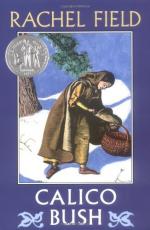
|
| Name: _________________________ | Period: ___________________ |
This test consists of 15 multiple choice questions and 5 short answer questions.
Multiple Choice Questions
1. What do the children talk about as they watch the men work at the Raising?
(a) They compare the men's stamina.
(b) They compare the men's work abilities.
(c) They compare the men's tools.
(d) They compare the men's clothing.
2. How does Marguerite get a bruise on her forehead?
(a) She is hit with debris while helping to save the livestock during a storm.
(b) She is punished by Joel Sargent for insolence.
(c) She is kicked by one of the children in their sleep.
(d) She falls below deck during the storm.
3. What does Dolly say at the beginning of Part 2 she is grateful for?
(a) Good neighbors willing to work.
(b) A good servant in Marguerite.
(c) Good weather for the Raising.
(d) The health of her children.
4. What does Marguerite think of her reflection after having not seen herself for many months?
(a) She thinks she looks like an Indian.
(b) She likes what she sees.
(c) She is unhappy with the shape of her nose.
(d) Her reflection seems odd to her becasue it has matured some.
5. What is the point of view of the novel?
(a) Third person omniscient.
(b) Third person limited.
(c) Second person.
(d) First person.
6. What job is Marguerite immediately given as the Raising starts?
(a) Cooking the wildfowl.
(b) Filling the spaces between logs on the new house.
(c) Watching over the children.
(d) Keeping flies from the food.
7. When Marguerite is awoken by the storm, what is the first thing she does?
(a) Reaches for the children.
(b) Reaches for her rosary.
(c) Reaches for her belongings.
(d) Reaches for her money.
8. What does Dolly Sargent use to nurse her baby on the ship?
(a) Cleaned pig intestines.
(b) A wooden cup.
(c) A rubber glove.
(d) A hollowed out gourd filled with milk.
9. What is a dory?
(a) A small boat.
(b) A bird.
(c) A tool.
(d) A large ship.
10. What crops did the Sargents plant upon their arrival that are just coming up in Part 2?
(a) Potatoes, rice, and watermelon.
(b) Corn, turnips, and potatoes.
(c) Potatoes, tomatoes, and beans.
(d) Corn, rice, and radishes.
11. Whose fresh dress and white knitted stockings makes Marguerite feel self conscious?
(a) Abby Welles.
(b) Mary Jane Morse.
(c) Eliza Stanley.
(d) Hannah Welles.
12. What image does Dolly suggest the neighbors will compare her children to if they are not washed and cleaned?
(a) Cows caught in a muddy paddock.
(b) A horse lathered in sweat after a heavy run.
(c) Pigs playing in slop.
(d) Sheep just brought in from the fields.
13. What is the name of the place where Marguerite and her grandmother end up after they run out of money?
(a) Hospice.
(b) Jail.
(c) Orphanage.
(d) Poor Farm.
14. Who is to sail with the Isabella B when it leaves for Portsmouth?
(a) Timothy and Abby Welles.
(b) Ira Sargent and Ethan Jordan.
(c) Timothy Welles and Ethan Jordan.
(d) Ira Sargent and Caleb Sargent.
15. Who is the main character of Calico Bush?
(a) Dolly Sargent.
(b) Aunt Hespa.
(c) Caleb Sargent.
(d) Marguerite Ledoux.
Short Answer Questions
1. Why does Becky Sargent suggest the dog, Pumpkin, smells Indians?
2. What is Marguerite untangling as the novel begins?
3. Who rescues Marguerite out of the water after she rescues the cow and calf?
4. What did the captain say takes you places without waiting for no road?
5. Who is Jerusha?
|
This section contains 559 words (approx. 2 pages at 300 words per page) |

|




